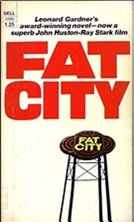Fri 8 Sep 2023
LEONARD GARDNER – Fat City. Farrar, Straus & Giroux. hardcover, 1969. Dell, paperback, 1972. Several later reprint editions have been published. Film: Columbia, 1922, directed & produced by John Huston.

Stockton, California. Circa late 60’s. A slice of the nowhere lives of second-rate boxers in a third-rate town.
“Billy Tully was a fry cook in a Main Street lunchroom. His face, a youthful pink, was lined around the mouth. There was a dent in the middle of his nose. Thin scars lay one above another at the outer edges of his brows…. It was the size of his neck that gave his clothed figure its look of strength. The result of years of exercise, of lifting ten- and twenty-pound weights with a headstrap, it had been developed for a single purpose — to absorb the shock of blows. Tully had not had a bout since his wife had left him, but last night he had hit a man…. He had thrown one punch and the man had dropped. Tully now believed he had given up his career too soon. He was still only twenty-nine.â€
What’s a retired boxer good for? At the peak, money coming in, girls like you, and like the money. The boys wanna be seen with you. To slap you on the back, to shake your hand, to buy you a drink. You’re a hero. And then suddenly it’s gone. All of it.
So after work he heads down to the YMCA. Spies Ernie Munger, “a tall, lean, sweating youth.†He invites him to box. “Smiling tolerantly, Tully pursued him. After that he felt only desperation because everything happened so quickly: smashes on his nose, jolts against his mouth and eyes, the long body eluding him, bounding unbelievably about the ring while Tully, flinching and covering, tried to set himself to counter. In sudden rage, he lunged, swinging like a street fighter, and his leg buckled. Hissing with pain, he began hopping around the ring.â€

Asks Tully to the Ernie: “How many bouts you had?â€
“None.â€
“You’re shitting me. How old are you?â€
“Eighteen.â€
“Well, you got it, kid. I fought Fermin Soto, I know what I’m talking about. I mean nobody used to hit me. They couldn’t hit me. They’d punch, I wouldn’t be there. You ought to start fighting.â€
“I don’t know. I just come down to mess around. Get a little exercise.â€
“Don’t waste your good years. You ought to go over to the Lido Gym and see my manager.â€
And so it begins for Ernie Munger. Billy Tully, Version 2.0.
But for Tully “life seemed near its end. In four days he would be thirty.â€
—-
A vivid glimpse of a grimy nowheresville, where boxing dreams gild the wilted lilies stroking the gutter. Where you come up for air a time or two. A hundred bucks in your pocket. Thinking you’re on top of the world, ma. Top of the world. Only to fall to the canvas. And rise again and again. And fall.
—
Like Ebert says of the film, if you like books about suffering and the burden of dreams, two big thumbs up!

September 8th, 2023 at 6:50 pm
A stunning book and film, but unremittingly grim. After a while it feels as if the reader has hit the canvas a few times.
That may sound like damning with praise, but truthfully it is a beautifully crafted book and film, both masterpieces of a sort, but downbeat is too mild a word to describe two works that are as unforgiving as the canvas the loser kisses.
September 8th, 2023 at 7:13 pm
Charles Willeford was a fan of the book.
http://woodyhaut.blogspot.com/2007/11/charles-willefords-library-though.html?m=1
September 9th, 2023 at 1:20 am
I think it OK to post the relevant paragraph here:
“-Leonard Gardner. Not so much lost as missing in action, Gardner’s only novel, Fat City, is one of the great hardboiled boxing novels. Originally published in 1969, the novels takes place in and around Stockton, California, where Gardner was born and raised, and would be adapted, with a script by Gardner, for the screen by John Huston a couple years later. Other than this novel, Gardner has, to this day, published very little, though his stories have appeared in The Paris Review, Esquire and Southwest Review. During the 1990s he contributed to a number of NYPD teleplays. Fat City, which takes place in gyms, seedy hotels and bars, prefigures the likes of Raymond Carver and Russell Banks.”